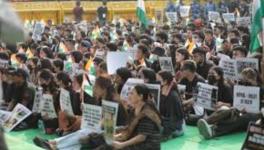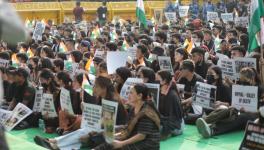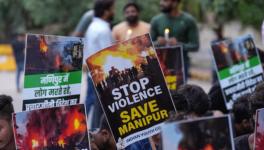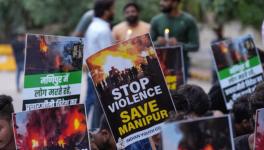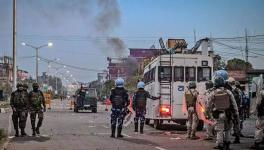Manipur’s Moonlighters: Working all day, on Bunker Shift at Night
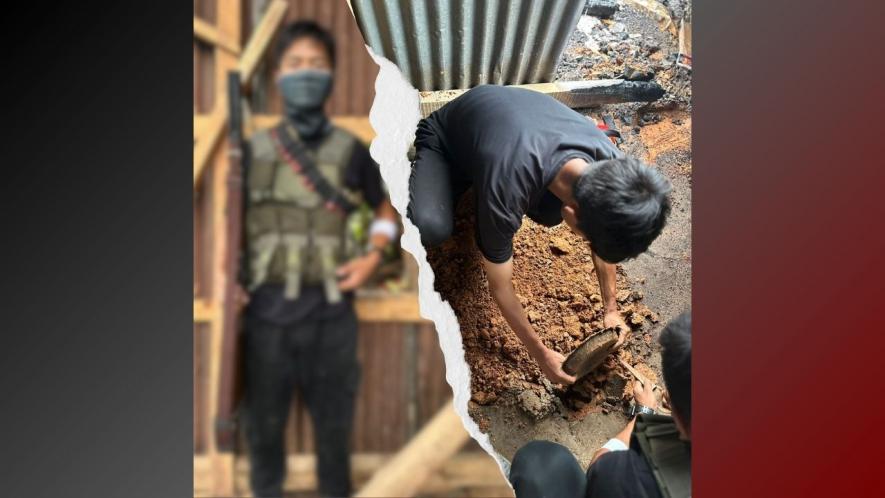
A battle-ready 21-year-old who works as a delivery agent for an e-commerce company (left). Two boys dig mud to build a bunker wall in the conflict zone. (right) | Photo credit: Aaisha Sabir
Imphal: “Today we are rebuilding this home, but as a bunker,” says Pao [name changed], who works as a delivery boy for four days during the week, and for the remaining three days, he defends his village, Langza, nestled amidst the hills of Manipur.
Langza, a Hmar-Kuki village in Churachandpur, is near the periphery bordering the Meitei-dominated area of a state divided along ethnic lines since the 3 May violence. The village was attacked in early July by “miscreants” who vandalised and burnt down homes, forcing villagers to flee.
What used to be a home in Pao’s village has now been reduced to three aluminium tin walls with wooden borders and a tin roof. The main fence lies broken in bits scattered in the mud.
The rain beating down on the tin roof does not distract Pao, as he digs a hole with a friend beside him. Both work to the rhythm of the falling rain. A splitter splatter above as they quickly scrape the soft mud into a bucket resting on the ground. In one corner is a broken shelf with books—half torn, half burnt, a few untouched—much like the village homes around them.
Pao was a delivery boy for Flipkart in Imphal, but after the 3 May conflict, his work—all his movements—were restricted to Churachandpur.
The 21-year-old carries buckets of the mud he is scraping to another spot. Slowly, over weekends, he has been building a bunker—a wall of mud-filled drums. He hopes it will be an adequate fortification if fresh violence breaks out. And on weekdays, he is a delivery boy for shops in Churachandpur.
“I was earning well. It was all going well for me. I had started contributing to my house, but now all that is over,” he says. The young man was eagerly waiting to become financially independent, but defending his village is the need of the hour.
He dusts his hand and picks up his double-barrel gun. Ready to fire or be fired at.
“We have to look out and defend ourselves. Imphal may have law and order, but it does not reach here,” says a village elder, speaking hesitantly and on the condition of anonymity.
In a village in Kangpokpi, a couple hours’ drive away, Peter, who graduated from Delhi University in 2022, talks about the job he procured as a content writer in February. He still works this day job Monday to Thursday but is at the bunker from Friday to Sunday, ready for war.
“We rotate shifts in the bunker. My friend will come on Sunday night and take over while I go to my regular job. We work in weekly shifts,” he says.
“I wanted to be a writer. When all this is over, and [if] I am still standing, then perhaps one day,” Peter says wistfully.
Over 100 days into the clashes, Manipur’s situation remains grim, which has affected the youth in the state as they are compelled to defend their community.
“At night, the firing comes from across the field, and we must be prepared,” says Ranjit, who is a web designer when he’s not manning the Meitei village periphery.
Despite the tumult, hardships, and struggle of juggling two jobs, Ranjit says he will not give up. He has taken the initiative to convince more men from his village, Sawombung in East Imphal, about an hour’s drive from Kangpokpi, to patrol the area.
“The Assam Rifles are around, but we don’t trust them. We cannot depend on them to protect us. If we [the youth] want a future, we must protect it now and defend our village,” he says.
The area around the buffer zone, which empirically “divides” the Meitei and Kuki communities, is calm as Ranjit and his friend, Naba, scan for movements through their binoculars. It is 4 pm. Naba says panic usually grips villagers after daylight submerges into darkness.
Naba has completed high school, but college enrolment is impossible this year. “I work here full time now,” he says, referring to the bunker.
Not many can stay for days at the bunker. There are hourly shifts too. “I work in sales during the day in a company based in Bangalore. But every evening after work, I come here,” says Haokip, a 24-year-old from Kangpokpi, who did not want to share his complete name.
He believes only the central government can restore peace in the state; otherwise, the violence can continue forever.
Haokip’s mother is not too happy with the arrangement. “I have been telling him to go back to Bangalore. He will not have a good life here. It would be different if things were normal here but look at the situation. Who would want their child to live here?” she says.
Asked if she was uncomfortable with Haokip brandishing a single-barrel gun, she says, “This is a fight for our land; he is protecting our village. If we don’t defend, we will be killed. So many people have died; we can be next. It is not an option as long as we live here and this war continues.”
When the violence erupted, offices, schools, institutes, and markets were shut, a curfew was imposed, and the internet ban followed. However, as markets gradually reopen for a few hours a day and the curfew slowly eases, schools and colleges have reopened in several areas. The result is that people have returned to work while they defend their villages.
“Now the youth juggle two jobs. Earlier [after 3 May], they only defended their villages. Several students preparing for entrance exams have decided to take a gap year and help in this fight,” said a Kuki movement member in Churachandpur, who also refuses to be named.
The baggage of unemployment has gripped Manipur for over a decade, but its youth have found a new sense of purpose amidst the conflict. As Pao says, “This is also my job.”
The author is an independent journalist who has visited Manipur to report on the ongoing violence. The views are personal.
Get the latest reports & analysis with people's perspective on Protests, movements & deep analytical videos, discussions of the current affairs in your Telegram app. Subscribe to NewsClick's Telegram channel & get Real-Time updates on stories, as they get published on our website.









